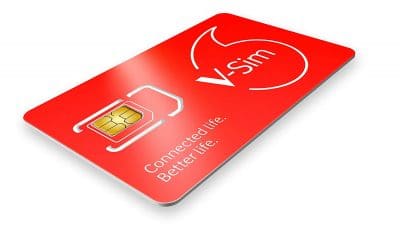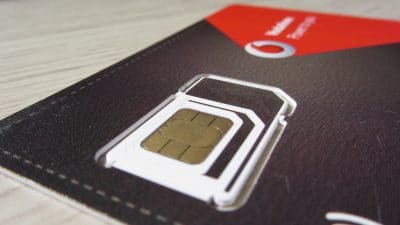The Best Portable Solar Chargers For Backpacking & Camping: In-Depth Guide To Foldable Solar Phone Chargers
Charging up your phone when you work in an office is no big deal. But what about if you’re frequently off the grid? Portable solar charges can be a good way to get the battery charge that you need when you’re away from a wall socket. But with so many options out there, which device should you be looking for? That’s why we’re here with everything you need to know about buying a solar charger, and we’ve even got some model recommendations for you too.
Table of Contents
- Why You Need a Portable Solar Charger
- A Word of Warning About Solar Phone Chargers
- Our Top Overall Pick
- What Are My Options?
- What Do I Need to Think About Before Buying?
- What Features Should I Be Looking For?
- How We Selected Our Top Portable Solar Chargers
- The Top 8 Portable Solar Chargers for 2020
- Portable Solar Chargers In-Depth Reviews
Why You Need a Portable Solar Charger

We’ll be honest, most people don’t need a solar charger. For most of us, a regular charger or power bank is the cheaper and more efficient option. However, if you often find yourself away from a power supply, if you’re a big camper or outdoorsy kind of person, or if you prefer using the sun’s energy rather than burning fossil fuels to charge your phone, then a solar charger might be for you.
A solar charger does exactly what you think it does, it harnesses the sun’s energy to charge your phone. That means that if you’re away from an electrical source, you can still charge your phone battery. Perfect for those emergency calls from the forest (or even a Facebook post from the top of a mountain!).
A Word of Warning About Solar Phone Chargers

Before we get into the ins and outs of which models are going to be best, it’s only fair that we give you the negative sides of solar chargers. Solar charges are expensive (more expensive than regular chargers or power banks). They’re fairly inefficient too, they take a long time to charge from the sun, can only be charged up when there actually is some sun, and tend to charge phones pretty slowly.
All this doesn’t mean that you shouldn’t buy one. If this is the only way to get power to your phone then you should certainly get one. However, if there’s another option for you (like a power bank or even just a bigger battery smartphone) then you’ll almost certainly be better off with that other option. So, the real outdoorsmen and women should read on to find out more about your options…
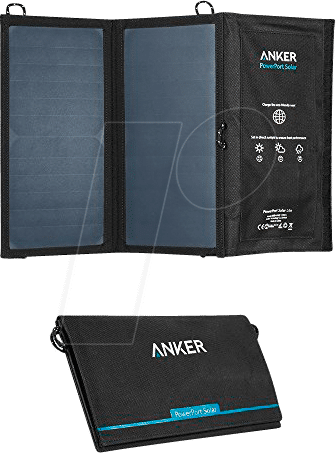
Our Overall Top Pick
The Anker Powerport Solar
This Anker Powerport is one of the most popular solar chargers around, and it’s easy to see why. With plenty of power, great amperage (so faster charging), and 3 USB ports, the Powerport is efficient, easy to use, and easy to carry around as well. There’s even short circuit and surge protection on board to protect your electronics.
What Are My Options?
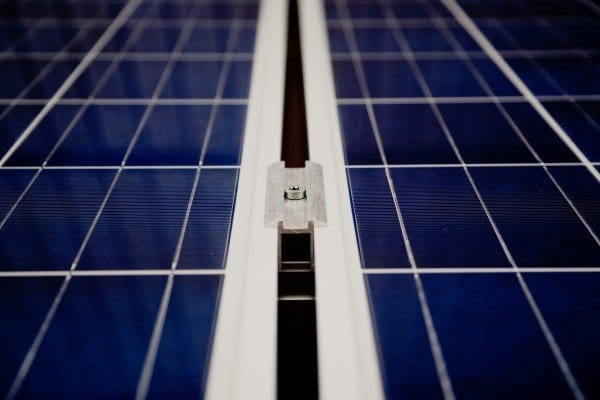
There are three basic kinds of solar chargers that all use different technology. The three available options are:
CIGS
CIGS stands for copper, indium, gallium, and selenide, the materials used to make the panels. These kinds of solar panels are very flexible and light, however, they’re also easily damaged and fragile. For this reason, you probably won’t find many options for phone chargers using CIGS tech. They’re also the least efficient of the three technologies, getting only around 16% efficiency.
Pros: Lightweight and flexible
Cons: Fragile and easily damaged
Best for: No one really, CIGS technology doesn’t make for great portable chargers since the panels are just too fragile to be outdoors for long.
Monocrystalline
Monocrystalline solar panels are much more rugged than CIGS panels, so they’re much more suited to being outside. They’re also heavier than CIGS panels though, but despite this, they can still be bent and formed into different shapes. They’re also the most efficient tech, getting around 22% efficiency. Most portable chargers you see will use monocrystalline panels.
Pros: Widely available, relatively flexible, rugged, and efficient.
Cons: Relatively heavy
Best For: Pretty much everyone, this is the most widely available tech for a reason, simply because it’s the best choice for a solar charger that you want to take outdoors.
Polycrystalline
Finally, polycrystalline panels are another option that you can occasionally see on shelves. In basic terms, they’re very similar to monocrystalline panels, with the same advantages and disadvantages. They differ in colour (polycrystalline panels are usually light blue, whilst monocrystalline panels are usually black). They also differ in efficiency, being less efficient than monocrystalline panels (around 18%). Devices with polycrystalline panels can be slightly cheaper than monocrystalline ones.
Pros: May be cheaper, relatively flexible and rugged
Cons: Less efficient than monocrystalline panels
Best For: Tough to say. If this is the only option that fits your budget then go for it, but on the whole, the more efficient monocrystalline panels are going to be a better buy, even if they cost a little more.
What Do I Need to Think About Before Buying?
Other than the technology used to make the solar panels themselves, you’ll need to think about a few other things before making your final decision:
Output Power
You’ll need to think about what you’re going to be charging with your charger since different devices need different amperage. In general, a smartphone will need at least 1 amp to charge effectively, but the more amps you get the faster your phone will charge (up to around 3 amps or so). Be sure to check the ports on the device you’re looking at to see what kind of amperage they get, and if there are multiple ports you’ll need to check the specs for all of them since often manufacturers put different amperage ports on a device.
Wattage
You’ll also need to check out the wattage of a charger since different kinds of devices require different wattages to charge properly. If you’re looking to charge a smartphone then you’ll need around 5 watts for an Android, but around 7 watts for an iPhone (7 watts will also be compatible with Androids!). If you want to charge more power hungry devices like tablets then you’ll need even more. The higher wattage you get, the faster your devices will charge, but you’ll also be looking at a higher price tag.
Connections/Ports
You’ll need to check out what kind of ports a charger has, though most come with a standard USB port. Some chargers will have multiple ports, letting you charge multiple devices. Don’t forget that you’ll need to take charging cables with you in order to charge your phone from the solar panel!
Integrated Batteries
Finally, you will want to consider whether or not you get integrated batteries with your charger. A charger without integrated batteries simply plugs straight into the phone and sits in the sun until the phone is charged. A charger with integrated batteries can sit in the sun and store its power inside the batteries, and you can then use those batteries to charge your phone at a later time (like at night). In general, integrated batteries are a very good idea. If you opt to go this route, then check battery capacity (shown in mAh). The higher the capacity, the more power batteries can store, so it’s best to go for the highest capacity you can afford.
In this particular review, we’re only looking at portable solar chargers that don’t come with an integrated battery. Fortunately, we’ve also taken an in-depth look at the best solar power banks, so if they’re more suitable then head over there.
What Features Should I Be Looking For?
As well as the big things mentioned above, there are other things that you’ll want to take into account when making your decision:
- Ruggedness: How durable is the casing for the charger? You’ll want something that’s durable and that isn’t going to break too easily if it gets dropped or shoved into a bag, real concerns with a device you’ll want to take outdoors.
- Waterproofing: Is the charger waterproofed? This isn’t an absolute necessity, but there’s always a chance that you’re going to leave the charger outside in the rain, or even spill something on it, so waterproofing could be a good idea.
- Weight: Keep in mind that you’re going to be carrying this charger with you when travelling, and every little bit of weight adds up. You want something light and portable.
- Convenience: The easier the charger is to set up and use, the more time you’ll save. Opt for something that’s intuitive and simple to use, even if that means fewer bells and whistles. Complicated technology really doesn’t belong in the outdoors…
How We Selected Our Top Portable Solar Chargers
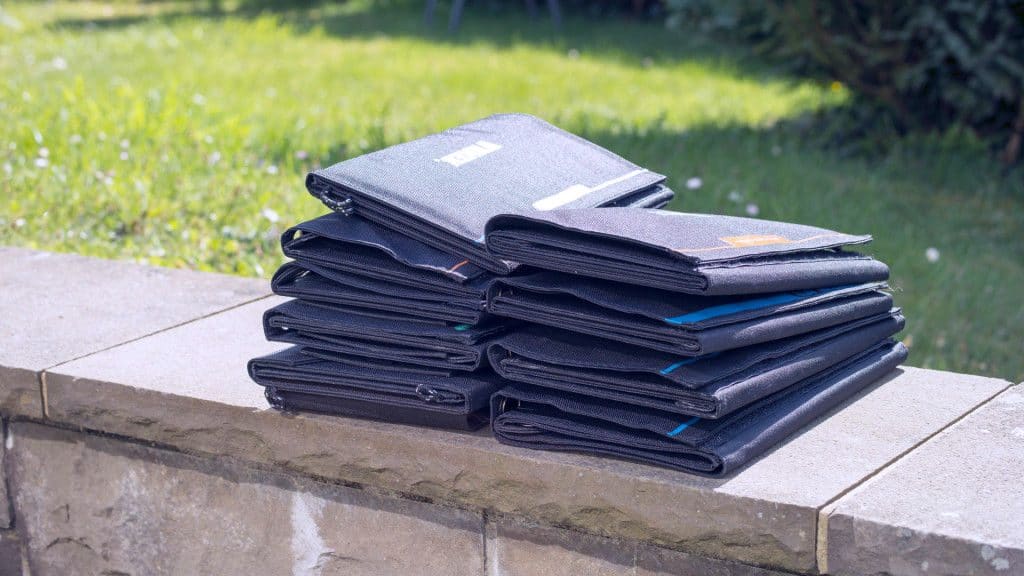
Just before we get on to our model recommendations though, first we should tell you how we went about choosing which models went on our list. We looked primarily for a good balance between price and specs. We choose to disregard CIGS solar panels as they’re simply too unreliable for outdoor use. We obviously looked at all the important points that we mentioned above as well.
Once we’d narrowed down our options a little we went on to look at customer feedback and reviews, so we knew how others rated the reliability of the products. We spend a lot of time around mobile professionals, the kinds of people who use mobiles, chargers, and solar chargers all the time, as well as the tech developers that make these kinds of products, so we got tons of professional feedback too on what to look for.
When we’d got our preliminary list it was time test the products for real. Based in Yorkshire with some fantastic hikes and walks a stone’s throw away we know a thing or two about the great outdoors. The only issue in late September would be the Sun but thankfully during our testing weekend, we got clear blue skies and reasonable levels of sunlight.
Overall we spent more than 12 hours testing our 8 top-rated solar chargers whilst walking the Yorkshire Three Peaks. After pulling in a couple of favours with the offer of free beer at the end of the walk each member of our testing team had the solar charger strapped to their backpack during the duration of the walk. The solar panel was connected to a fully drained RAVPower 10000 mAH Power Bank which we’d purchased as part of our power bank reviews.
In an ideal test, we would have used a voltage meter to accurately track charging capabilities however this was unpractical for the walk.
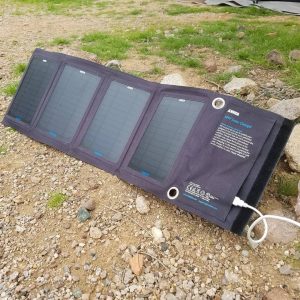
Instead decided to see how many times our eight solar recharged power banks could charge a Samsung Galaxy J6 2018 model which packs a 3,000 mAh battery. We were fortunate to have a surplus of twenty of the devices to hand from a recent giveaway which gave us more than enough to play with.
A full 10,000 mAh power bank should be able to charge the phone fully three times. But could any of our solar chargers generate enough power to fill a 10,000 mAh power bank during a 12-hour walk? The answer was no.
The top performer was the Anker Powerport Solar 21W which managed to give the RavPower enough for two full charges of the Galaxy J6. The 7 others were all just slightly behind. Based on our testing we think you’d need around 12 hours of strong sunlight to fill a 10,000 mAh power bank which won’t be a problem in many parts of the world, but in the UK? Not very likely!
Alongside charging, each reviewer was asked to give their feedback on using the charger, hanging it, weight, build quality and anything else that came to mind when using it.
So now it’s time to get to those recommendations. Which portable solar chargers should you be considering?
The 8 Best Portable Solar Chargers for 2020
| Rank | Product | Features | Pros | Cons | |
|---|---|---|---|---|---|
|
1
|
The Anker Powerport Solar 21W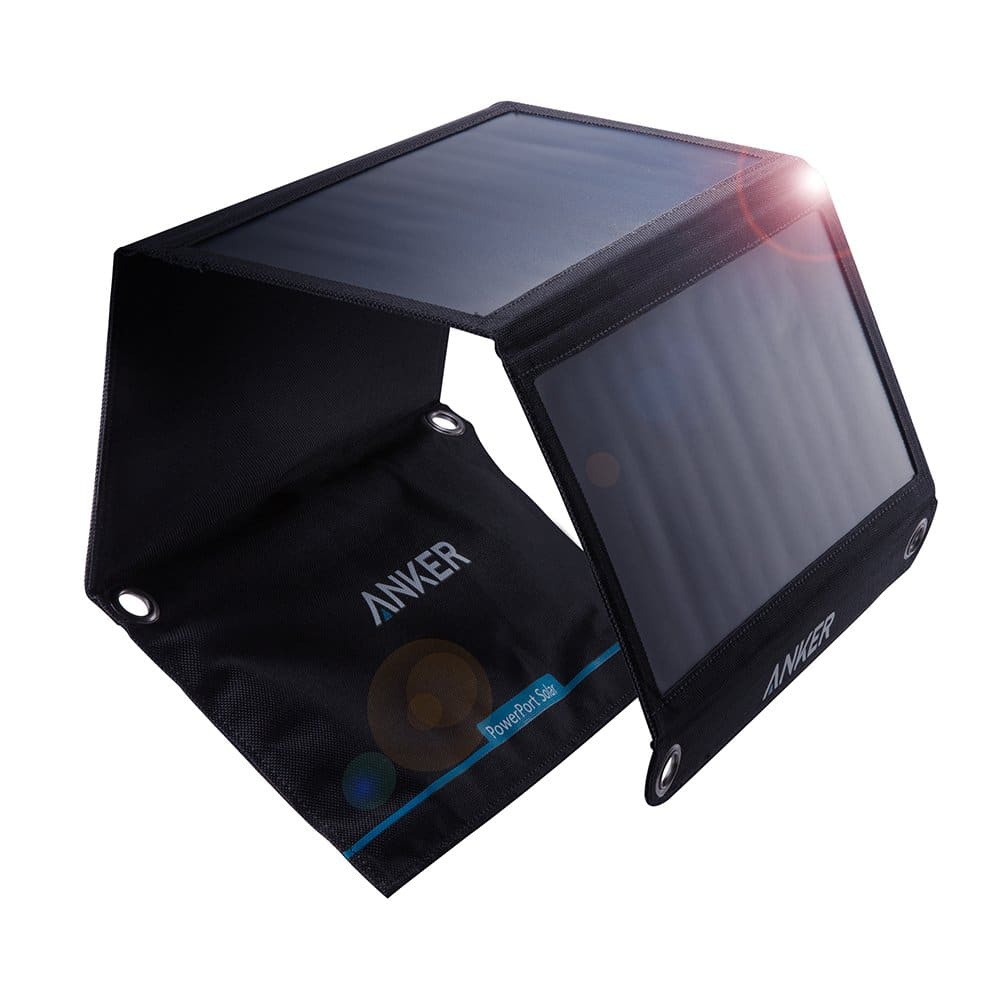
|
|
|
|
|
|
2
|
BigBlue 28 Watt Solar Charger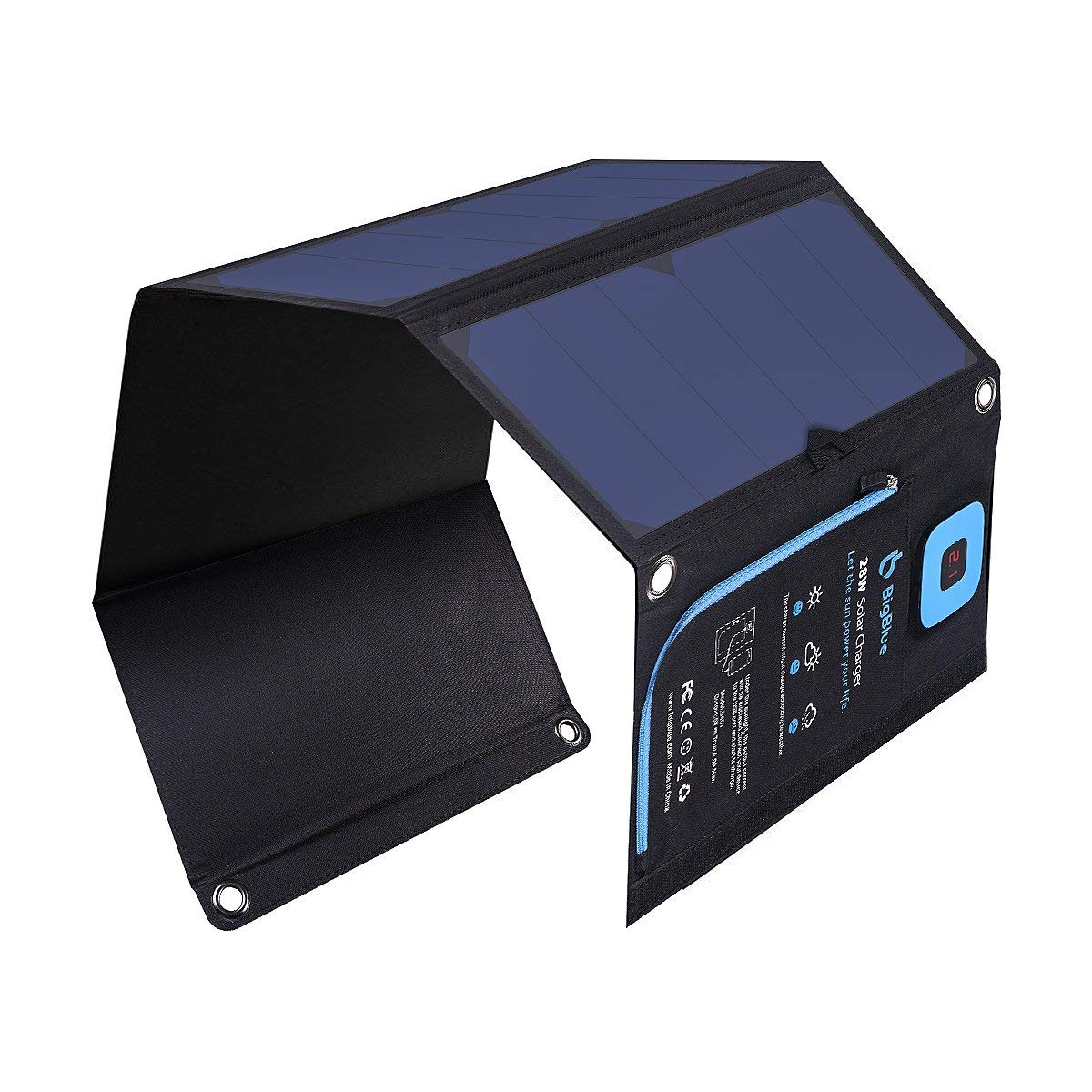
|
|
|
|
|
|
3
|
RAVPower UK RP-PCOO5(B)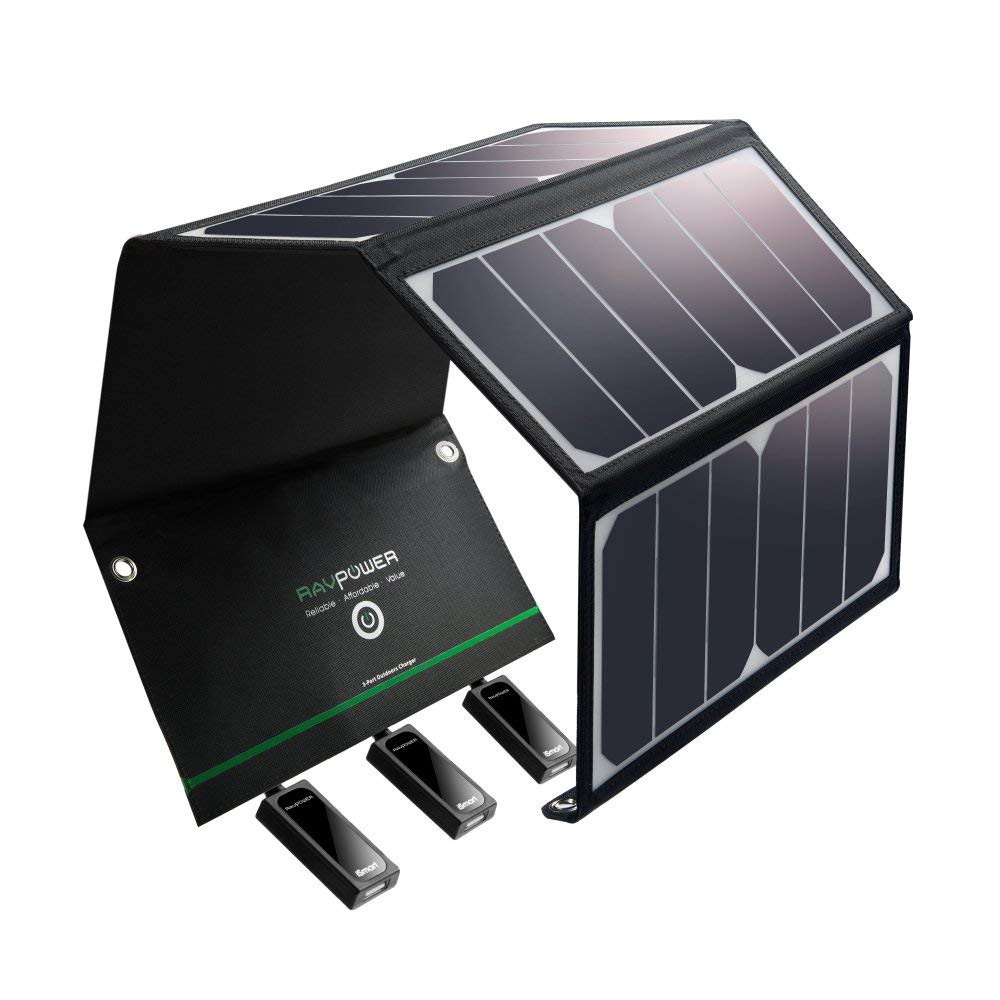
|
|
|
|
|
|
4
|
FLOUREON Solar Charger 28W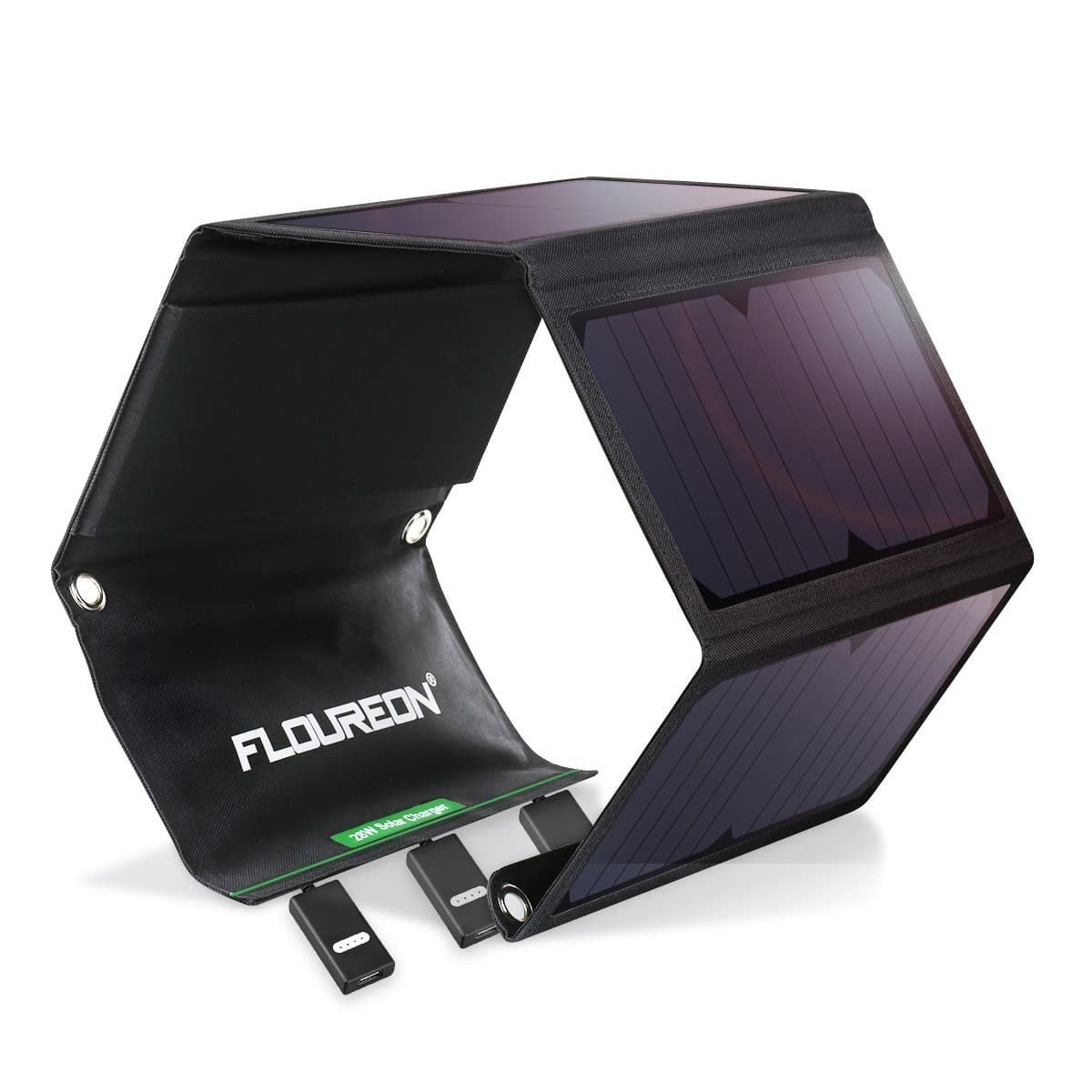
|
|
|
|
|
|
5
|
Nekteck 21W Solar Charger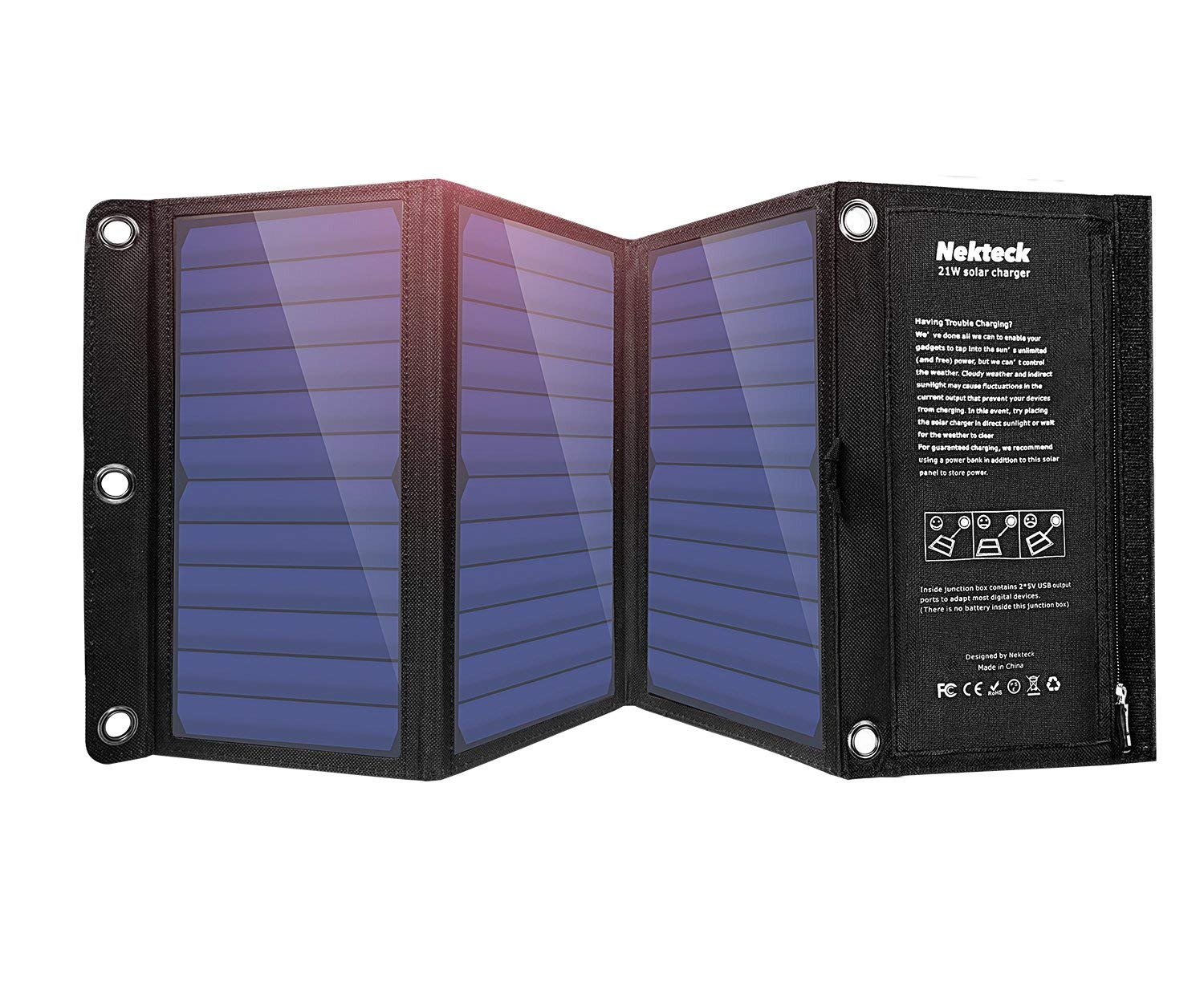
|
|
|
|
|
|
6
|
Goal Zero Nomad 20 Solar Panel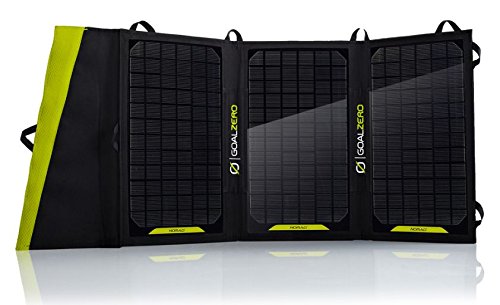
|
|
|
|
|
|
7
|
Anker Powerport Solar Lite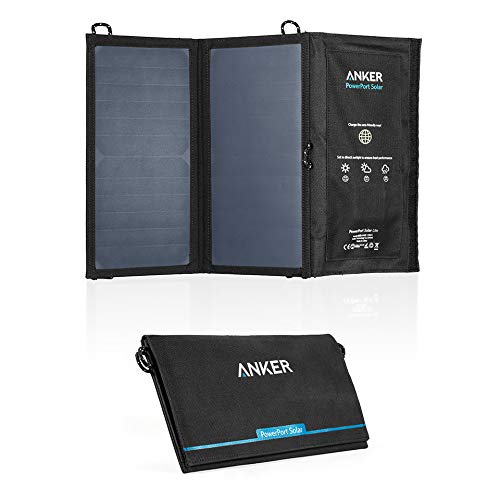
|
|
|
|
|
|
8
|
Dragon-X 40w Solar Charger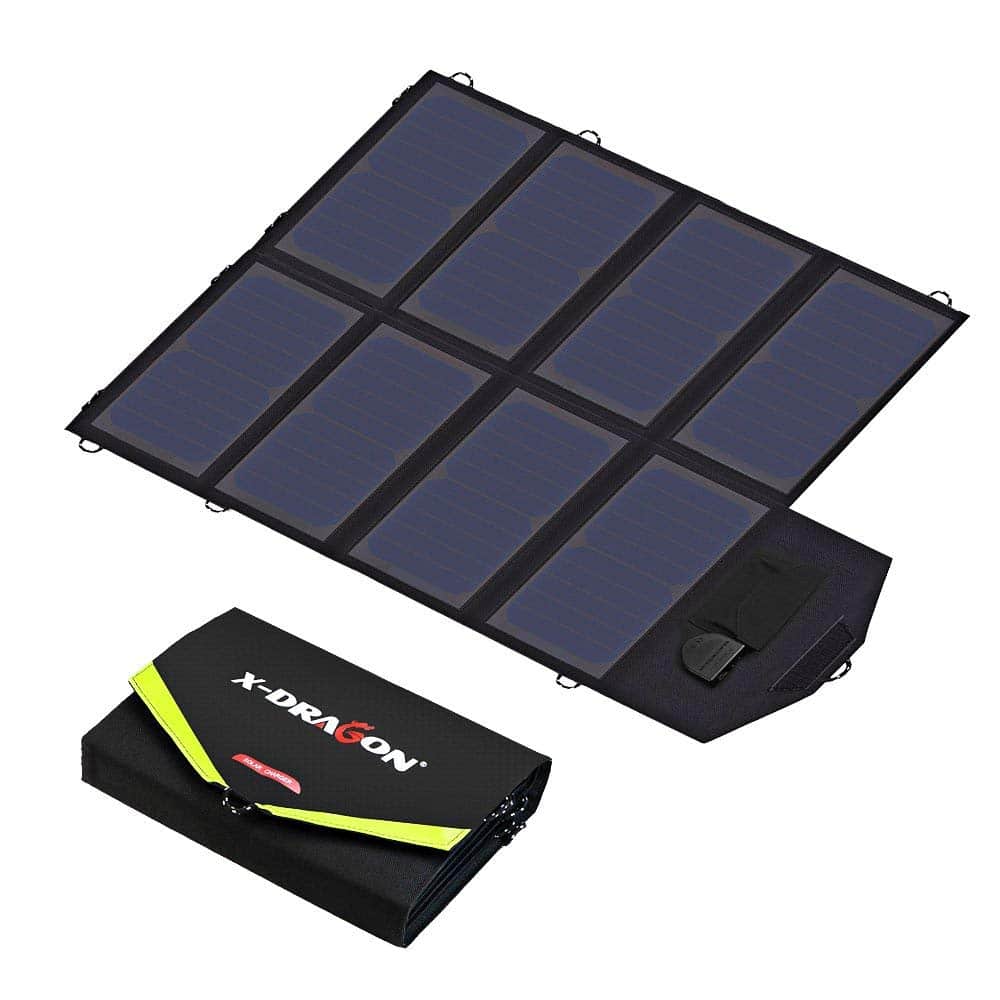
|
|
|
|
Portable Solar Chargers Full Buying Guide
Hopefully, you’ve now got a better idea of what you should be looking for. However, there are still tons of options on the market. That’s why we’ve put together a list of our top favourite portable solar charger models so that you can get some inspiration.
The Anker Powerport Solar (Monocrystalline)
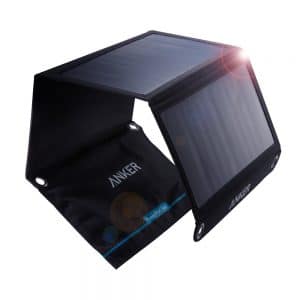
Wattage: 21 watts
Amperage: 2.4 amps per port
Efficiency: approx. 22%
Number of Ports: 3
Integrated Battery: No
Weight: 458 grams
This Anker Powerport is one of the most popular solar chargers around, and it’s easy to see why. With plenty of power, great amperage (so faster charging), and 3 USB ports, the Powerport is efficient, easy to use, and easy to carry around as well. There’s even short circuit and surge protection on board to protect your electronics.
The charger folds to a very portable 11×6 inches, and it’s nice and lightweight. It also includes a polyester canvas base which makes it rugged and durable, and Anker PowerIQ tech to ensure that your devices charge as quickly as possible.
On the downside, there’s no integrated battery, so you’re going to need to leave your phone attached to the charger outside in the sun. And whilst that canvas base is durable, it’s not waterproof, so you’ll need to be at least a little careful.
Pros
- Plenty of power
- 3 USB ports
- Simple to use
Cons
- No integrated battery
- Not waterproof
The BigBlue 28 Watt Solar Charger (Monocrystalline)
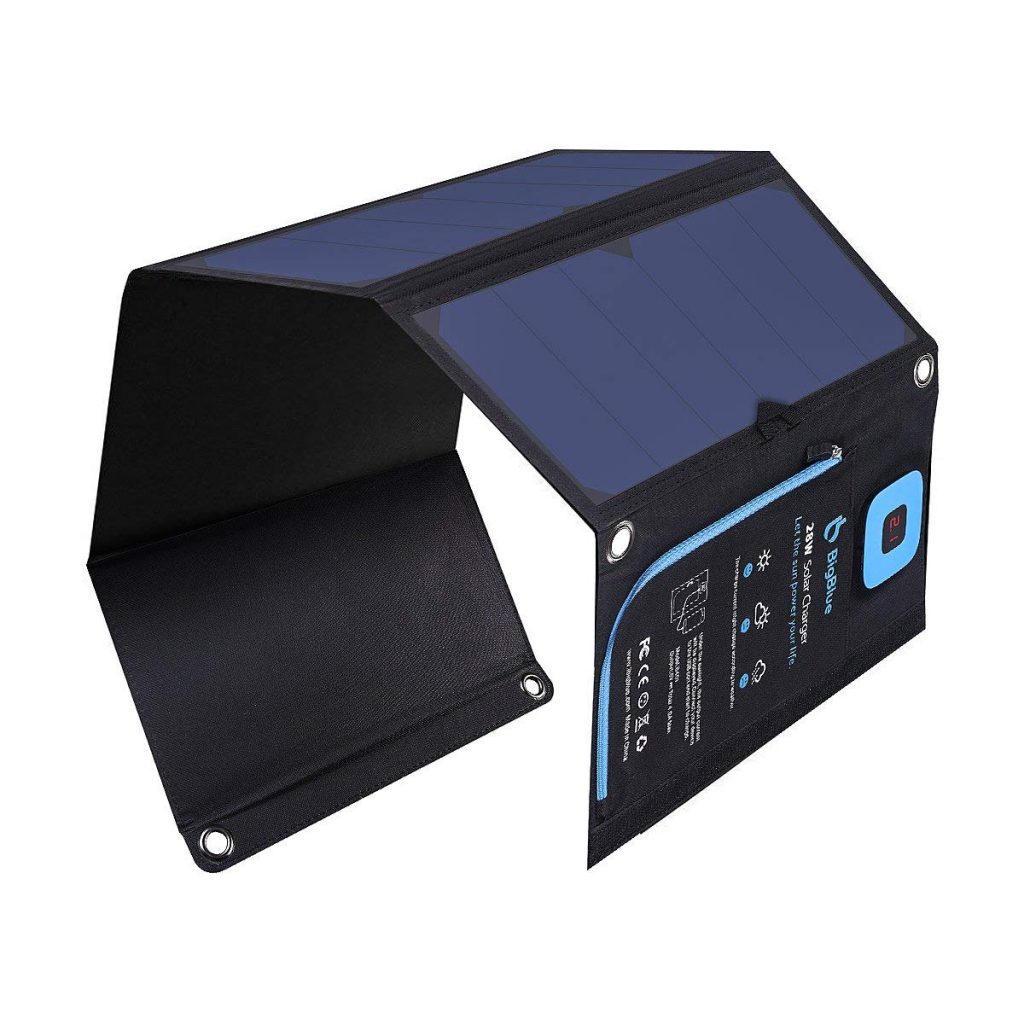
Wattage: 28 watts
Amperage: 2.4 amps per port
Efficiency: approx. 22%
Number of Ports: 2
Integrated Battery: No
Weight: 590 grams
BigBlue makes some of the most popular solar chargers, and this model is the ideal choice. You get plenty of power, great amperage, and a digital readout so you can see exactly how many amps are going into your device. It’s got two charging ports, and comes with metal hooks included so you can easily attach the panel to your bag or a tree to allow for easy charging.
The panel comes in a fold-out pouch, making it portable and easy to carry, and that zippered pocket can be used to store your phone whilst it’s charging, keeping it safe and sound. The heavy-duty polymer surface and the pouch is somewhat waterproof, enough to protect the panels though not necessarily your phone itself during a heavy rainstorm. And the panels can also elevate outwards, giving you a stronger charge.
The obvious downside here is the lack of integrated battery since you’ll need to keep your phone connected during sunlight hours. This isn’t a particularly light device either. But as far as pure solar chargers go, the BigBlue is a hit with other customers, and it’s a fantastic option.
Pros
- Plenty of power
- Elevated solar panels mean better charging
- Mostly waterproof, easy to hang
Cons
- No integrated battery
- Relatively heavy
The RAVPower UK RP-PCOO5(B) (Monocrystalline)

Wattage: 24 watts
Amperage: 2.4 amps per port
Efficiency: approx. 22%
Number of Ports: 3
Integrated Battery: No
Weight: 748 grams
If you’re looking for a beefy charger, then this RAVPower unit might fit the bill. IT gets a full 24 watts at 2.4 amps per charging port for each of the three USB ports, giving you plenty of power there. You get a big solar surface area to capture more sunlight, but a fairly portable design in that it folds up nicely to slide away into your bag.
In terms of convenience, this device is as good as it gets. It’s plug and play, so use is intuitive. It comes with hanging hooks, allowing you to hang it pretty much anywhere you please. And it’s fully waterproof, always a good idea in the outdoors. Thanks to the fact that its nylon it’s pretty rugged too, though not quite as durable as one of those military grade battery integrated chargers.
On the negative side, it’s pretty heavy for something of this side, heavier than many battery integrated chargers. And there’s no battery, so you’ll be forced to charge your phone only when the sun is shining. However, it’s a big, beefy, solar only charger, which might be just what you’re looking for.
Pros
- Lots of power
- 3 USB ports
- Easy to use and relatively portable, not to mention waterproof
Cons
- No integrated battery
- Relatively heavy for something of this size
Floureon Solar Charger 28 Watts (Monocrystalline)
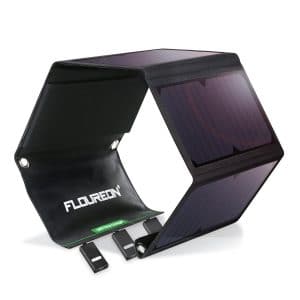
Wattage: 28 watts
Amperage: 7.2 amps (all ports simultaneously)
Efficiency: 23.5%
Number of Ports: 3
Weight: 950 grams
If you’re looking for a big yet affordable option, then the Floureon Solar Charger is for you. You get a whopping 28 watts and 7.2 amps across three USB ports, so there’s more than enough power here, and that 23.5% efficiency is pretty impressive too.
Where the Floureon shines is in its features though. You get LEDs to tell you charging status, you get full waterproofing (though you’ll still need to remember to protect your non-waterproof phone!). You get metal hooks so you can stick the panels on your bag whilst walking. You even get a bracket to appropriately angle the panels if you choose to place them on the ground. And there are all the normal safety features too, like short circuit protection.
The only real negative here is that customer reviews suggest that customer service might not be a top priority for Floureon, with emails and questions going unanswered. As a device though, this is an awesome, fairly low budget choice.
Pros
- Waterproof
- Loads of power
- 3 USB ports
Cons
- Customer support isn’t great
- Heavier than some options
Nekteck 21 Watt Solar Charger (Polycrystalline)
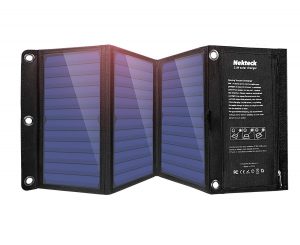
Wattage: 21 watts
Amperage: 2 amps per port, 3 amps simultaneously
Efficiency: 21-24%
Number of Ports: 2
Weight: 510 grams
Weight can be a problem with some solar chargers (they’re heavier than you might expect), but this Nekteck device is one of the lightest and most portable models around. There’s plenty of power with 21 watts and 2 amps per port for each of the two ports, and efficiency is great as well with between 21 and 24%. Unfolded you’re getting around 67 x 28 square centimetres, so plenty of area, and folded you’re looking at 28 x 16 so fairly portable too.
Though the Nekteck isn’t completely waterproof it is fairly weatherproof on the outside, and the canvas backing is tough and durable. There are reinforced holes to allow you to hang the charger where you please, though hooks are not included this time. And SmartIC tech will let the charger identify a device and ensure that it charges at the maximum possible speed.
The flipside here is that there aren’t many extras. There are no LEDs to show charging status, no included metal hooks. And given the fact that this isn’t completely waterproof, you will have to be a little careful. But for a lightweight, budget-friendly option, the Nekteck is the way to go.
Pros
- Good power
- Lightweight relatively
- Durable and tough
Cons
- No LEDs
Goal Zero Solar System (Monocrystalline)

Wattage: 20 watts
Amperage: 2 amps
Efficiency: Unknown
Number of Ports: 1
Weight: 1.1 kilos
With the Goal Zero Solar System, you’re getting what looks initially like a fairly basic, standard solar charger. But there are some nice features here. First up, you get a solid 20 watts of power, 1 charging port, and around 2 amps. You’re looking at some impressive area too, with around 77 x 33 square centimetres of area (though it folds down to a more manageable 33 x 21).
Where the Goal Zero really excels is that the panels can be connected together. That means if you buy more than one device you can hook them together, giving you more power. It also connects to a power pack if you prefer, to store energy (you’ll need to buy that separately). It’s durable and heavy duty, so there are no worries there.
On the downside, it’s a little heavy and a little pricey, but considering the convenience of being able to link panels together, this really is an awesome choice.
The Anker Powerport Solar Lite (Monocrystalline)

Wattage: 15 watts
Amperage: 2.1 amps per port
Efficiency: approx. 22%
Number of Ports: 2
Integrated Battery: No
Weight: 376 grams
The Powerport Solar Lite’s big brother, the regular Powerport Solar, has already made an appearance on this list, and the Lite version is on here for very similar reasons. If you’re not looking for a big, high powered charger, then this Lite charger is going to be the way to go. You get 15 watts, double ports, and 2.1 amps per port, so enough power to keep you going. But portability is really a key here, with this charger folding down to a very small size and tucking away inside a handy pouch.
The polyester canvas pouch and base make for a rugged and durable charger that shouldn’t suffer from being shoved into a bag. You get short circuit and surge protection, as well as PowerIQ to ensure that your devices are charging at their maximum speeds. You also get a fair amount of waterproofing, though your actual phone won’t be particularly protected, so you’ll need to be careful of that.
On the downside, there’s not a ton of power, and if you’re able to spend a little extra you might want to go with the regular Powerport. And you’re not going to get the strength here to charge anything much more than a phone (including power banks, tablets, and other electronics). But in terms of a budget, monocrystalline pure solar charger, the Powerport Lite is a fantastic choice.
Pros
- Double USB ports
- Easy to use and very portable
- Relatively durable and weatherproof
Cons
- Not a whole lot of power
- No integrated battery
The Dragon-X 40w Solar Charger (Monocrystalline)

Wattage: 40 watts
Amperage: 2.8 amps per port
Efficiency: approx. 23%
Number of Ports: 2 (one for smartphones, one higher voltage for tablets and laptops)
Integrated Battery: No
Weight: approx 1 kilo
Finally, we’ve got one of the biggest and most powerful chargers around. This massive eight-panel solar charger gets you a whopping 40 watts of power, enough so that you get a laptop/tablet charging port as well as a regular smartphone charging port. And despite its size, it still folds down and tucks into a very portable little pouch.
The panels themselves are super efficient, and the device comes with hooks so you can easily hang it on your bag to catch the sun during the day. It’s rugged and durable thanks to the high-quality base material. And you get a short circuit, overcharging, and power surge protection too.
All this power does come at a price though. This is the most expensive solar charger on our list by far, which could be a deal breaker. And that laptop charging port isn’t for everyone, so if you only need to charge your phone you might want to go with a cheaper, less powerful model. But if you want the best of the best, then this is going to be the device for you.
Pros
- Tons of power
- 2 USB ports (one for smartphones, one for laptops and tablets)
- Very portable
Cons
- Fairly expensive, particularly given that there’s no integrated battery
- Heavier than other options



